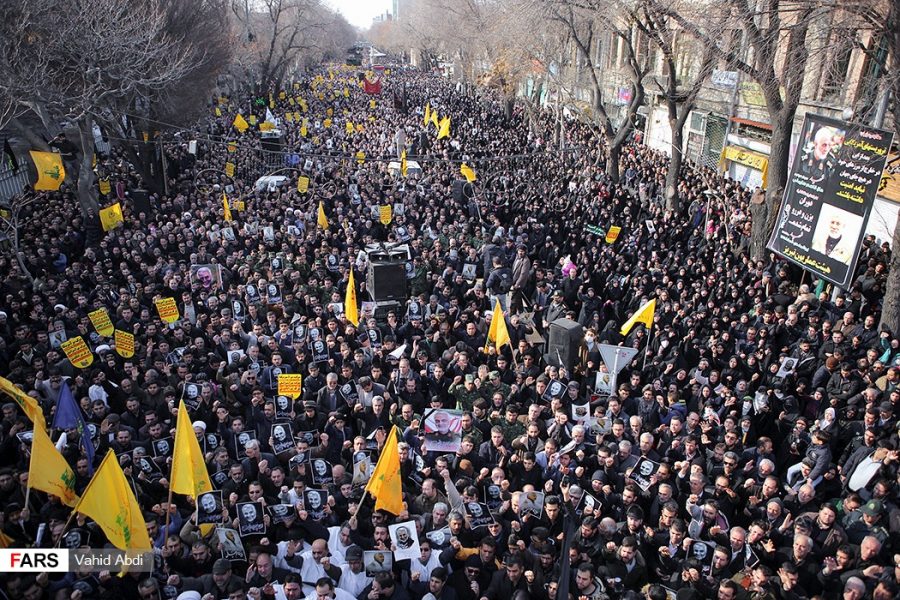What Happened in Iran: the US Airstrike and the Aftermath
February 3, 2020
President Donald Trump, without the knowledge of Congress, authorized an airstrike that hit a convoy at the Baghdad International Airport in Iraq on Jan 2. Among nine other casualties, four members of the Islamic Revolutionary Guard Corps, and five Iraqi members of the Popular Mobilization Forces. The strike killed Major General Qassem Sulemani, leader of the Quds Force. The Quds Force is an offshoot of the Iranian Islamic Revolutionary Guard that specialized in intelligence and unconventional warfare. However, Sulemani’s role in Iran was much larger than his title.
Sulemani was a vital member of the Iranian military for the past two decades. His power influenced not only military operations, but foreign policy and intelligence as well. He had a complicated role in the Iranian military, leading many classified operations. Sulemani spearheaded the majority of Iran’s foreign military operations and also managed dozens of Iranian backed militias and paramilitary groups throughout the Middle East and surrounding regions. It is hard to overestimate the amount of influence Sulemani held in his two-decade tenure.
The Trump administration and the Pentagon’s message in regards to Sulemani has been confusing. In a press conference four days after the attack, Chief of Staff General Mark A. Miley said that Sulemani was planning imminent “significant combat operations against U.S. military forces.” However, Defense Secretary Mark Esper, although confirming the threat in the same conference, claimed that “Soleimani alone has the blood of hundreds of Americans.” and therefore the public couldn’t “expect us not to respond.” Neither the Pentagon or the White House has released any such evidence to the public. On the other hand, the original impetus for any military action against Iran was in retribution to the riots at the U.S. embassy in Iraq a few days earlier.
Iraqi citizens began to protest at the U.S. embassy in Iraq on Dec. 31 because of U.S. airstrikes targeting Iran-backed militias in Iraq and Syria two days earlier. The protestors breached the outer wall of the embassy, vandalized it, and tried to light it on fire. The protestors withdrew from the embassy the next day, but one U.S. contractor died during the protests. This led to the Pentagon presenting Trump with a list of potential military responses, one of which was killing Maj. General Sulemani.
After the death of Sulemani, Iranian and Iraqi citizens began to protest against the U.S. in large demonstrations across both countries. The citizens’ fervor was only increased by the lengthy funeral procession for Sulemani on Jan. 4. It seemed, for at least a few days after the airstrike, that tensions between the U.S. and Iran would lead to further military action. Multiple high-ranking Iranian officials vowed revenge on the U.S. following the attack. Trump responded by tweeting out that if Iran took any retribution for the killing of Sulemani, The U.S. would send airstrikes to 52 sites that are “important to Iran & the Iranian culture.” This would be considered a war crime, and Trump’s tweet was quickly refuted by the Pentagon.
The Iraqi government passed a resolution on Jan. 5, saying that U.S. troops had to leave the country or it would be considered an occupation. The Pentagon responded by saying that they had no plans to leave Iraq, even if the Iraqi government didn’t agree. On the same day, the Iranian government ended its nuclear limits.
However, the escalation was short lasted. Trump walked back his threat of missile strikes and the Iranian government said they would only act defensively.
Several days after the crisis, a Ukrainian passenger jet was shot down by an Iranian surface to air missile killing 176 civilians, an incident which grimly echoes the downing of Iran Air flight 655 by the United States in 1988. The Iranian government immediately launched an investigation into the incident and they declared it was an accident although other investigations are still ongoing. The downing of the plane ended any perceived solidarity between Iranian and Iraqi civilians and the Iranian government with protests beginning shortly after the incident. The Iranian police cracked down on the protest just as they have before, with gunfire. Iran said that they would send the black boxes of the downed plane to Ukraine, however, as of Jan 22, that has not happened.
The events in Iran only reenforce how volatile Iran-U.S. relations are and with policy decisions like the U.S. withdrawal from the Iran Nuclear deal and ongoing proxy wars in both Yemen and Syria, it seems that this tension is as dangerous as ever.
